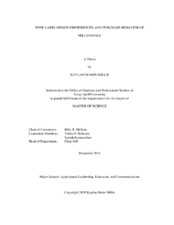| dc.description.abstract | Marketers of wine companies are expanding their efforts to capture the newest generation of wine drinkers, Millennials. Further research is needed to understand this generation as wine consumers. In this study, we investigated the factors that influence Millennials’ wine purchasing behavior and what characteristics of wine labels are most desirable, unattractive, and appear valuable to Millennials. Also, virtual reality incorporated into wine labels is a new marketing phenomenon. Little or no evident research has been done to understand if this adds value to a product and encourages Millennials to recommend the wine or purchase it. The target population for this study was Millennials between the ages of 21 and 37, and the sample consisted of 68 self-selected participants. A cross-sectional, quantitative, case study design was used and data were collected using two methods: Tobii Pro X2-60 eye tracking and a questionnaire. Based on the results of this study, we concluded Millennials purchase and/or consume wine weekly or multiple times per month. Millennials reported spending between $10.00 - $14.99 per bottle of wine, and the majority of the participants purchased their wine at the grocery store. Millennials included in this study reported being open to change and enjoy multiple types of wine. When creating a label with Millennials as the target consumer, it is important for wine makers and/or marketers to include the type of wine and the description of taste on the label, as these elements are the most influential in aiding purchasing decisions. Millennials indicated traditional labels were more attractive in comparison to non-traditional labels, favoring the layouts, names, and logos. Based on eye-tracking results, the greatest number of fixations occurred in the background of wine labels. Smaller elements on a wine label were viewed for longer durations, and elements that did not require deep cognitive processing, such as the name, were viewed for less time. Also, experiencing virtual reality changed the elements participants fixate on the most, and the duration of those fixations. The virtual reality aspect also added value to the product, based on the perceived value of the wine. Millennials enjoyed the virtual reality experience, believe it was easy to use, and reportedly will download and recommend the app to others. | en |


